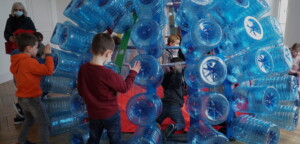Ben Uri has launched the first full scale virtual museum. The strategy to go primarily online was formulated in 2018, but has proved to be ahead of its time in a pandemic world.
Is virtual the key to future-proofing museums, accessing a wider audience and raising revenue in a post-COVID world? 2020 saw a drastic drop in tourism with all sectors of the attractions industry hit. Travel bans and lockdowns caused tourist figures to drop exponentially and the American Alliance of Museums estimated that US museums have been losing $33 million per day because of coronavirus closures. It warns that around a third of the country’s museums may not reopen, without significant financial assistance.
However 2020 also saw the rise of the virtual visit with museums and galleries offering online content. Over 2,000 museums worldwide shared virtual tours of their collections, including The Royal Academy of Arts, Tate Britain, the National Gallery, the British Museum, the Met, the Guggenheim, the Musée d’Orsay, and the Riijksmuseum.
The Ben Uri Gallery and Museum in London believes online is the way forward, particularly for smaller institutions, and is transitioning to a full scale virtual museum.
Reducing running costs and increasing accessibility
The museum soft-launched in September 2020 and David Glasser, chair of Ben Uri, says engagement numbers have exceeded expectations, with 35 times as many digital engagements than visitors to the physical gallery. They expect over 2 million views in the first year online, from which they will build engagement.
“Making the quantum shift to, and investment in, the virtual arena has given us unrestricted capacity for content and unlimited possibilities,” says Glasser. “Digital global engagement comes with crucially important benefits of reduced running costs and 24/7 accessibility.”
The museum will engage through 20 different digital platforms and already offers around 100 films, 60 podcasts and 200 school programmes. Its research unit is preparing a study and operational proposals on digital possibilities for the small to medium museum sector – the report is due to be published in April.
A sustainable museum business model
In 2018 Ben Uri published its future Sustainability and Public Benefit Strategy. The decision was made to transition to a full scale virtual museum as the principal engagement portal, supported by the current small gallery and art reference library. This was financed by the sale of works outside what was assessed as the main collection which represents the work of the Ben Uri Research Unit on the Jewish and immigrant contribution to British visual culture since 1900.
This transition has enabled Ben Uri to weather the pandemic. The Museum has not furloughed any staff and has not received any emergency public funding. In fact Ben Uri has increased professional staff numbers and is continuing to recruit in 2021 in order to deliver its strategic public benefit programmes and charity objectives.
The digital future of museums
“One way in which Covid has been positive is that it has enabled us to reach people we wouldn’t have reached otherwise,” says Manal Ataya, Director General of Sharjah Museums, in an interview with Blooloop. “Because we became a lot more digitally savvy and we’ve put a lot more of our collections and our exhibitions online.”
She points out that the group’s museums have been a surge in online visits, both from within the UAE and internationally. “These are people who would not physically visit the museum, and who would not otherwise have seen the exhibition; now, they have been able to see the virtual tour and to access information,” she says.
The Birmingham Museum and Art Gallery (BMAG) in the UK has gone one step further, partnering with online AI-driven art and game platform Occupy White Walls (OWW). Players can curate their own exhibitions within a virtual BMAG.
“The pandemic has reinforced the importance of our digital work and ensuring our audiences can still access the collection, even when we are closed,” says Linda Spurdle, head of digital at Birmingham Museums. “Partnering with Occupy White Walls is just one of the ways we are looking to grow engagement levels with the city’s digital database of artworks and encourage people to explore it and use it creatively.”
Raising revenue through virtual initiatives
There’s no doubt museums and other institutions can raise awareness and traffic through virtual offerings, the question remains whether they can also generate revenue without physical visitors.
“One of the most straightforward ways to start generating revenue through digital channels is to charge a fee for digital events, just as you would for in-person events,” says Brendan Ciecko, CEO and founder of Cuseum (cuseum.org) writing for the AAM. He cites the example of the Mattatuck Museum which hosted its annual Murder Mystery event online, charging $10 – $15 for its #QuarantineEdition.
Other museums have opted for a pay-per-view type telepresence during 2020, including Hastings Contemporary and the Van Abbe Museum.
Virtual memberships, courses and camps
Online membership offers are another revenue stream, with interactive, content-rich access to museums’ collections. The National Steinbeck Centre charges $30 per year for access to private archives, behind the scenes tours while the Seattle Museum of Art offers a members-only lecture series as part of its online perks. Developing virtual courses and even online versions of summer camps and events can be an additional source of revenue, says Ciecko. The Denver Museum has been ahead of the game, offering its Virtual Science Academy programme ($140) to students and school classes well before COVID. It now sees it as even more vital, both for its students and its revenue.
Avoiding paywall alienation
Putting all content behind a paywall may alienate potential audiences, so some museums are trialling a “pay what you want” approach for digital content. Institutions such as the Phoenix Art Museum, Farnsworth Art Museum, and the Tracy Aviary & Botanical Garden have found this approach highly successful, with average donations higher than the original fixed fee considered.
Shifting perceptions
The last year has shown inventive responses to physical constraints in the museum sector, as well as the wider industry. Many institutions are finding the restrictions are offering surprising opportunities, and difficult questions as to whether, and how, these can be monetised.
David Glasser of Ben Uri concludes: “The traditional view of ‘there’s nothing to replace the physical experience” totally misunderstands and misjudges today’s, never mind tomorrow’s, world in which we live.”
Header image: Ghetto Theatre by David Bomberg













